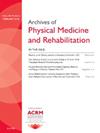对脊髓损伤后性行为的性阳性观点:定性荟萃[16]
IF 3.6
2区 医学
Q1 REHABILITATION
Archives of physical medicine and rehabilitation
Pub Date : 2025-04-01
DOI:10.1016/j.apmr.2025.01.010
引用次数: 0
摘要
数据来源 5 位作者对 6 个在线数据库(Web of Science、Scopus、PubMed、PsycINFO、MEDLINE、Embase)进行了系统检索。检索词使用 PICo 框架进行组织,并在学术图书馆员的支持下进行了开发。检索词包括人群:"脊髓损伤或 "脊髓损伤*"或 "脊髓 "或 "脊髓创伤 "或 "脊髓损伤 "或 "四肢瘫痪*或截瘫*或四肢瘫痪*;兴趣:性*或性*或感官*或亲密或亲密关系;背景:定性或 "焦点小组 "或 "基础理论 "或访谈*或人种学或现象学或现象学或经验。如果论文:关注性/亲密关系、包括 SCI 参与者、定性(包括访谈和焦点小组)、英语、经同行评审、定性研究结果表达清晰,则被收录。如果是定量或混合方法,如果研究人员无法辨别 SCI 参与者的声音,无法获得全文,或者是论文或灰色文献,则排除在外。通过对 6 个数据库进行系统检索,发现了 3,655 篇有关性行为和 SCI 的文章。通过标题和摘要筛选,将这些文章缩减到 144 篇进行全文筛选,再进一步缩减到 33 篇进行专题综合分析。数据提取将数据提取到 NVIVO 中进行编码和专题综合。所有论文至少由两名作者进行比较编码。然后由 4 位作者将编码归类为描述性主题。整个研究团队对这些主题进行反复讨论和重新评估,以形成分析性主题。结论针对 SCI 后性活动促进因素的 6 个分析性主题包括:对性活动不断发展的理解、新的和其他的性表达方式、性活动活跃、获得适当的资源、拥有合适的伴侣以及建立性自我。我们将在演讲中对这些内容进行深入讨论,并在即将出版的期刊文章中发表。这项研究的结果采用了一种新颖的性积极性视角,分析了 33 篇有关性行为和 SCI 的定性论文的结果。研究结果可用于指导临床实践和未来的性积极研究。本文章由计算机程序翻译,如有差异,请以英文原文为准。
Toward a Sex-positive View of Sexuality After Spinal Cord Injury: A Qualitative Metasynthesis 0416
Objective(s)
To explore facilitators of sexuality for people with spinal cord injury (SCI) using a strengths-based and sex-positive approach, we conducted a systematic review and qualitative metasynthesis of qualitative studies.
Data Sources
A systematic search of 6 online databases (Web of Science, Scopus, PubMed, PsycINFO, MEDLINE, Embase) was conducted by 5 authors. Search terms were organized using the PICo Framework and were developed with the support of an academic librarian. Search terms included: Population: “spinal cord injur*” OR “spinal injur*” OR “spinal cord” OR “spinal cord trauma” OR “spinal cord lesion” OR quadriplegi* OR paraplegi* OR tetraplegi*; Interest: sex* OR sexual* OR sensual* OR intimate OR intimacy; Context: qualitative OR “focus group” OR “grounded theory” OR interview* OR ethnography OR phenomenology OR phenomenological OR experience. Papers were included if they: focused on sexuality/intimacy, included participants with SCI, were qualitative (including interviews and focus groups), were in English, were peer-reviewed, and their qualitative findings were clearly articulated. They were excluded if they were quantitative or mixed methods, if the researchers were unable to parse out the voice of the participants with SCI, full text was not available, or were thesis or gray literature.
Study Selection
Studies were imported into Covidence Systematic Review Software for screening and each paper was screened at every point by at least 2 authors. A systematic search of 6 databases found 3655 articles about sexuality and SCI. Title and abstract screening narrowed these down to 144 for full-text screening, further narrowed to 33 articles to be analyzed using thematic synthesis.
Data Extraction
Data were extracted into NVIVO for coding and thematic synthesis. All papers were comparatively coded by at least 2 authors. Paper quality was assessed using the Joanna Briggs Institute Critical Appraisal Checklist for Qualitative Research.
Data Synthesis
Codes were then grouped into descriptive themes by 4 authors. Themes were iteratively discussed and reassessed by the entire research team, to develop analytical themes.
Conclusions
The 6 analytical themes addressing facilitators for sexuality post-SCI included: an evolving understanding of sexuality, new and other ways of sexual expression, being sexually active, access to appropriate resources, having the right partner, and establishing a sexual self. These will be discussed in-depth in our presentation and published in an upcoming journal article. The results of this study use a novel lens of sex-positivity to analyze the results of 33 qualitative papers on sexuality and SCI. Results can be used to inform clinical practice and future sex-positive research.
Disclosures
none.
求助全文
通过发布文献求助,成功后即可免费获取论文全文。
去求助
来源期刊
CiteScore
6.20
自引率
4.70%
发文量
495
审稿时长
38 days
期刊介绍:
The Archives of Physical Medicine and Rehabilitation publishes original, peer-reviewed research and clinical reports on important trends and developments in physical medicine and rehabilitation and related fields. This international journal brings researchers and clinicians authoritative information on the therapeutic utilization of physical, behavioral and pharmaceutical agents in providing comprehensive care for individuals with chronic illness and disabilities.
Archives began publication in 1920, publishes monthly, and is the official journal of the American Congress of Rehabilitation Medicine. Its papers are cited more often than any other rehabilitation journal.

 求助内容:
求助内容: 应助结果提醒方式:
应助结果提醒方式:


